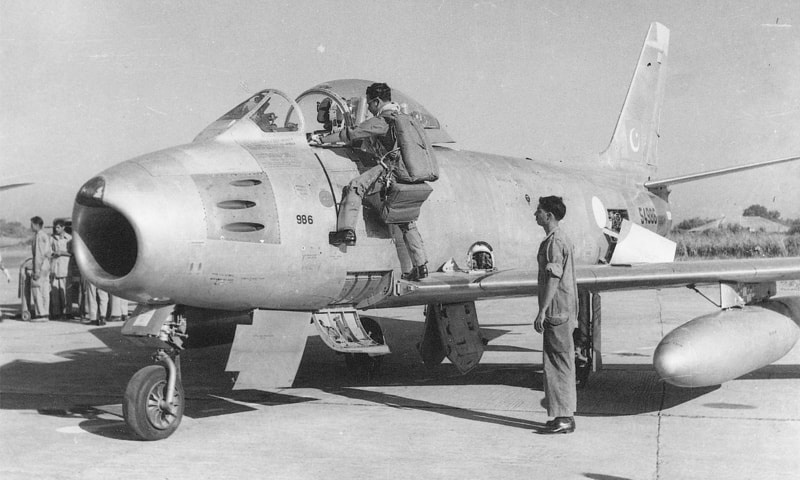By Major (R) Haroon Rasheed – Defence & Strategic Analyst
Since its inception, the Pakistan Air Force (PAF) has demonstrated professionalism, technological advancement, and tactical brilliance in various confrontations with its eastern neighbor, India. From the roaring skies of the 1965 war to the recent Operation Bunyanoon Marsoos, PAF has consistently maintained an upper edge over the Indian Air Force (IAF) in several critical engagements.
A Fan Left Rs 72 Crore Property To Sanjay Dutt Before She Died
Pakistan Air Force Triumphs at 2025 Royal International Airshow in UK
World Hepatitis Day being observed today
For more such Opinions & Blogs, click here.
1965 Indo-Pak War – PAF Dominates the Skies
The 1965 war was the first major aerial confrontation between India and Pakistan. The PAF, equipped with F-86 Sabres and guided by tactical brilliance, delivered a series of decisive blows to the IAF. Within days, the PAF had achieved air superiority over key battle zones.
PAF shot down over 60 Indian aircraft while losing only 19.
The bold strike on Pathankot airbase, which destroyed multiple IAF assets on the ground, was a strategic masterstroke.
Air Commodore MM Alam became a national legend by shooting down five Indian aircraft in under a minute, an unparalleled feat in air combat history.
1971 War – Despite Numerical Inferiority, PAF Fights Gallantly
Though outnumbered and outgunned, the PAF held its own in the 1971 war.
PAF destroyed more than 70 Indian aircraft.
The war saw intense dogfights and strikes deep inside enemy territory.
Pilots like Rashid Minhas (Shaheed) showcased immense courage and earned global recognition.
While the overall outcome of the war was politically difficult for Pakistan, PAF’s performance remained commendable and inflicted significant damage on the IAF.
Week-long Polio drive begins in Balochistan’s Sensitive UCs
Ishaq Dar: Afghan Stability Is in Pakistan’s Interest
Bandipora hospital awaits completion despite passage of nine years
Kargil Conflict (1999) – Strategic Restraint and Readiness
Though not an all-out air war, during the Kargil Conflict, PAF maintained complete aerial readiness. Despite India’s use of Mirage 2000 for precision strikes, PAF’s calculated restraint and preparedness prevented any airspace violations.
The PAF played a silent but strategic role, keeping IAF at bay.
PAF radar coverage and high-altitude surveillance prevented Indian expansion beyond Line of Control (LoC).
Operation Swift Retort (2019) – A Modern Masterclass
Following India’s Balakot strike in February 2019, PAF launched Operation Swift Retort – a carefully planned and flawlessly executed counter-strike.
PAF successfully locked and targeted Indian military installations without crossing the LoC.
In the ensuing dogfight, PAF shot down two Indian aircraft, including a MiG-21 Bison and SU-30, capturing Wing Commander Abhinandan Varthaman, who was later released as a peace gesture.
This encounter re-established PAF’s superiority in tactics, speed, and discipline.
P. Chidambaram says, there is no evidence of Pakistan’s involvement in the Pahalgam attack
Tata Consultancy Services, India’s Largest IT Services Provider, To Cut 12,000 Jobs
Week-long Anti-Polio drive to begin in Balochistan tomorrow
Operation Bunyanoon Marsoos (2025) – PAF’s Next-Gen Warfare
The most recent confrontation, Operation Bunyanoon Marsoos, came as a response to India’s Operation Sindoor in May 2025.
PAF deployed JF-17 Thunder Block III, equipped with RD93MA engines, AESA radar, and long-range air-to-air missiles, which outclassed Indian Rafales and Su-30 MKIs.
The PAF’s electronic warfare, stealth capability, and network-centric operations overwhelmed the IAF’s defensive grid.
Within 72 hours, PAF had neutralized multiple radar stations, destroyed 13 IAF aircraft, and achieved air dominance over contested sectors.
Technological Superiority and Indigenous Growth
Over the decades, PAF has invested smartly in state-of-the-art aircraft and indigenous development.
JF-17 Thunder, co-developed with China, has become the backbone of PAF, especially the Block III variant.
Integration of Chinese stealth drones, AWACS systems, and cyber capabilities has pushed PAF into next-gen warfare.
Unlike India, which relies heavily on imports, PAF has nurtured local aviation ecosystems like PAC Kamra.
India creating atmosphere of fear and terror in IIOJK: Mushaal
Kashmiris term Aug 5 as declaration of war, vow to resist Indian occupation
6 dead, over 25 injured in stampede at Haridwar’s Temple
Training and Doctrine – The PAF Advantage
PAF’s edge isn’t just technological; it’s institutional.
PAF pilots undergo world-class training at institutions like the PAF Academy Risalpur and Combat Commanders School (CCS).
Emphasis on doctrine, decentralization of command, and joint operations ensures tactical flexibility.
Conclusion
Guardian of the Skies
From the dogfights of 1965 to the network-centric warfare of 2025, the Pakistan Air Force has consistently proven its superiority, adaptability, and strategic brilliance. Its commitment to modernization, indigenous capability, and professional ethos ensures that it remains the guardian of Pakistan’s airspace and a formidable deterrent against any aggression.
“Second to None” is not just a motto — it’s a legacy
For more such Opinions & Blogs, click here.
Boeing jet catches fire on runway in US, panicked passengers slide out amid smoke
Air India releases Rs 25 lakh interim aid to families of 166 crash victims
Thailand, Cambodia agree to hold immediate ceasefire talks: Trump
77th martyrdom anniversary of Captain Muhammad Sarwar Shaheed, Nishan-e-Haider today
Asia Cup in UAE from September 9 to 28, India-Pakistan clash on September 14
Major (R) Haroon Rasheed is a retired officer of the Pakistan Army and a defense analyst focusing on South Asian strategic affairs and emerging military technologies.
Stay tuned to Baaghi TV for more. Download our app for the latest news, updates & interesting content!






